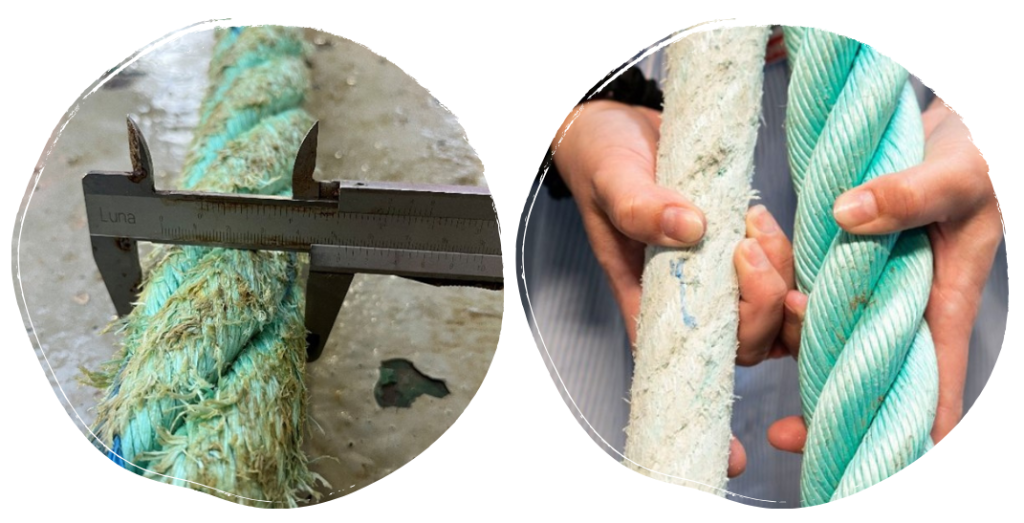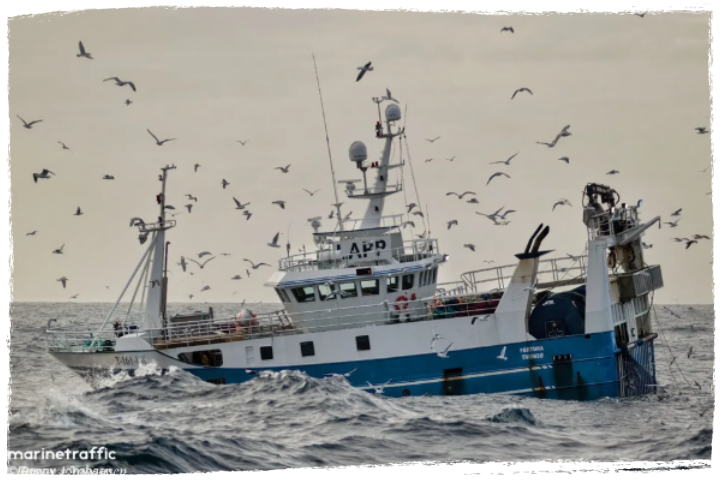Future fibres? Developing biodegradable seine ropes
Published 08/05/2025
In demersal seine fisheries, the ropes used to encircle and haul catches face high rates of wear and tear. Being dragged repeatedly across the seabed, they’re exposed to substantial abrasion. To withstand this, these ropes are built with a steel core, coated in synthetic plastic fibers. Over time, the synthetic coating degrades, shedding microplastics into the marine environment. This not only contributes to the growing issue of marine plastic pollution but also creates a costly problem for fishers, who need to frequently replace ropes to maintain performance.

The SEARCULAR team are developing and testing a new biodegradable coating for demersal seine ropes. The idea is to replace conventional synthetic plastic coatings with an innovative biodegradable polymer that is designed to break down in seawater. This means that as the rope sheds microfibres from abrasion at the seabed, the microfibres will degrade naturally, instead of contributing to microplastic pollution in our oceans. Additionally, the biodegradable material is designed to withstand more friction than the current synthetic materials used. This means that, if successful, these bio-seine ropes will last longer, reducing waste, cost and raw materials required for their replacement.
We chatted with Anja Alvestad, research scientist in Fisheries and New Biomarine Industry at SINTEF Ocean and project lead for this SEARCULAR solution, to talk about the development and testing processes of a new material, and the team’s progress since SEARCULAR began last year.
Looking back over your first year of SEARCULAR, is there any work you are particularly proud of in your team?
Anja: Our first year working on this project has been really fulfilling. We’ve put a lot of effort into building our understanding of demersal seine ropes and the conditions they need to withstand. We’ve spent time engaged directly with fishers who are using these ropes, to learn about the practical challenges they face. Visiting our partner, SELSTAD’s rope factory in Norway was also crucial, helping us better understand the technical aspect of rope design, the materials currently used, and the production process involved. This combination of technical insight and real-world feedback has been essential in shaping our laboratory testing and guiding the direction of our material development.
This knowledge has helped us improve our laboratory testing, where we simulate abrasion under controlled, yet realistic conditions to evaluate different types of biodegradable materials. To date, we have tested nine different biodegradable monofilaments, assessing their tensile strength and durability, and have observed some very positive results.
Based on this lab testing we have selected one promising biopolymer which is now being tested in the field with one of our partner fishing vessels. This will allow us to analyse how the rope performs in real life conditions – an important step in understanding whether the new material is suitable for practical use.
Another great achievement for our team is securing additional funding from the Norwegian government, which has allowed us to extend the scope of our work and improve our laboratory testing, allowing for more accurate simulations of the abrasion our final product will encounter in commercial fisheries. This will provide additional data that will benefit SEARCULAR directly, but also improve our knowledge of demersal seine gear in general – knowledge that can be shared with the wider fishing industry.
I think it’s also important to acknowledge the challenges we have faced during this time. What we’re trying to do is very complex, so, of course, there are going to be aspects that are unpredictable and surprising. One of the primary challenges has been finding a material that performs as well as, or better than, the one currently used by fishers in order to be a suitable alternative. However, we believe these challenges can be overcome. By working closely with fishers, gear manufacturers, and other research partners, we’re able to adjust and improve our approach based on real needs and practical experience. Their input helps us make sure that we’re developing something that’s not only better for the environment, but also works in the real world.

Left: Measuring the level of wear in a demersal seine rope that has undergone abrasion. Right: a comparison of used (left) and new (right) ropes. Image Credit: Sintef.
Looking forward, what are your team’s plans and goals for the next year?
Anja: Our end goal is to produce full-scale biodegradable seine ropes, and at the moment we’re on track to achieve this by summer! Once the ropes are ready, they will be tested aboard a working Norwegian demersal seine vessel, called Fortuna, for one to two fishing seasons. After this trial period, we will collect the ropes for analysis to see how the new material has held up under real-life conditions. We will also talk to the fishers to gain insights on how the rope performed relative to their regular ropes. We’re all very excited about this next step, and we are also hoping that the vessel’s name will bring us good luck as well!
At the same time we want to improve our laboratory abrasion testing so that it more accurately reflects what happens at sea. Using the additional funding we have secured from the Norwegian Government, we are exploring new methods for simulating rope wear. The current methods abrade the rope on one side, but when being used in real conditions, demersal seine ropes spin and are exposed to abrasion on all sides. Our goal is to develop a new method to ensure new ropes are being tested and abraded in a way that is much closer to how they are actually used.
What does your work mean for SEARCULAR and others?
Anja: Collaboration is key to our success. We have built a strong partnership with our biopolymer supplier, SENBIS, and our seine rope manufacturers, SELSTAD – no one knows seine ropes like they do! We’ve also spent a lot of time working directly with fishers to understand their hands-on experiences with the traditional ropes to help inform our approach to the design and introduction of our new, more sustainable rope.
Even if we don’t succeed in creating a new commercially viable biodegradable seine rope, the knowledge we have gained along the way is incredibly valuable and will be useful for improving the standard ropes currently used to result in fewer microplastics being released into our oceans.
The importance of what we’re doing is really clear. The biodegradable material could considerably reduce the amount of microplastics released into sensitive marine environments, as the material would naturally break down in seawater. And by developing a material that is more resistant to friction, we could also reduce the frequency of rope replacement for fishers – benefitting both the environment and the fishers themselves.
Ultimately, it’s about recognising a problem, but remaining positive/optimistic. That’s why we refer to our projects as solutions – because each step forward brings us closer to a real, positive change.

The fishing vessel Fortuna which will be trialling the new biodegradable seine ropes. Image Credit: marinetraffic